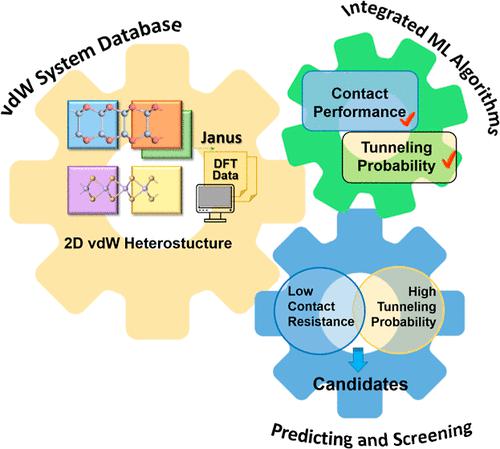当前位置:
X-MOL 学术
›
Chem. Mater.
›
论文详情
Our official English website, www.x-mol.net, welcomes your feedback! (Note: you will need to create a separate account there.)
Accelerated Mining of 2D Van der Waals Heterojunctions by Integrating Supervised and Unsupervised Learning
Chemistry of Materials ( IF 8.6 ) Pub Date : 2022-06-14 , DOI: 10.1021/acs.chemmater.2c00641 An Chen 1, 2 , Zhilong Wang 1, 2 , Xu Zhang 3 , Letian Chen 4 , Xu Hu 4 , Yanqiang Han 1, 2 , Junfei Cai 1, 2 , Zhen Zhou 3, 4 , Jinjin Li 1, 2
Chemistry of Materials ( IF 8.6 ) Pub Date : 2022-06-14 , DOI: 10.1021/acs.chemmater.2c00641 An Chen 1, 2 , Zhilong Wang 1, 2 , Xu Zhang 3 , Letian Chen 4 , Xu Hu 4 , Yanqiang Han 1, 2 , Junfei Cai 1, 2 , Zhen Zhou 3, 4 , Jinjin Li 1, 2
Affiliation

|
The contact resistance of the metal–semiconductor interface at the source and drain increases as the injection of carriers decreases, degrading the device performance. Reducing the Schottky barrier height (SBH) at the metal–semiconductor interface is an effective way of reducing the contact resistance. Therefore, exploring Ohmic contact (no Schottky barrier) or low contact resistance two-dimensional (2D) semiconductor/metal heterojunctions is critical for developing high-performance electronic devices. We generate a comprehensive dataset from the periodic table consisting of 1092 potential 2D semiconductor/metal heterojunctions with good contact performances and demonstrate that the small interfacial dipole and the elimination of localized surface states are essential for designing advanced 2D metal–semiconductor systems with small SBHs. We use integrated supervised and unsupervised learning, as well as first-principles calculations, to screen 6 potential 2D van der Waals metal–semiconductor heterojunctions (BTe–NbSe2, Al2SO–Zn3C2, iAl2SO–Zn3C2, GaSe–NbS2, GaSe–NbSe2, and GeSe–VS2) with Ohmic contact and high tunneling probabilities from 1092 candidates. The proposed method takes less than 5 s to execute and is far superior to traditional first-principles calculations in both time and cost, demonstrating the superiority of using machine learning for screening materials and that unsupervised assisted algorithm can alleviate the problem of data scarcity to predict the behaviors of complex dynamical systems.
中文翻译:

通过集成监督和非监督学习加速二维范德华异质结的挖掘
随着载流子注入的减少,源极和漏极处的金属-半导体界面的接触电阻增加,从而降低了器件性能。降低金属-半导体界面处的肖特基势垒高度(SBH)是降低接触电阻的有效方法。因此,探索欧姆接触(无肖特基势垒)或低接触电阻二维(2D)半导体/金属异质结对于开发高性能电子器件至关重要。我们从元素周期表中生成了一个综合数据集,该数据集由 1092 个具有良好接触性能的潜在二维半导体/金属异质结组成,并证明了小界面偶极子和局部表面态的消除对于设计具有小 SBH 的高级二维金属-半导体系统至关重要。2 , Al 2 SO–Zn 3 C 2 , iAl 2 SO–Zn 3 C 2 , GaSe–NbS 2 , GaSe–NbSe 2 , 和 GeSe–VS 2 ) 来自 1092 个候选者,具有欧姆接触和高隧穿概率。所提出的方法执行时间不到 5 秒,在时间和成本上都远优于传统的第一性原理计算,证明了使用机器学习筛选材料的优越性,并且无监督辅助算法可以缓解预测数据稀缺的问题复杂动力系统的行为。
更新日期:2022-06-14
中文翻译:

通过集成监督和非监督学习加速二维范德华异质结的挖掘
随着载流子注入的减少,源极和漏极处的金属-半导体界面的接触电阻增加,从而降低了器件性能。降低金属-半导体界面处的肖特基势垒高度(SBH)是降低接触电阻的有效方法。因此,探索欧姆接触(无肖特基势垒)或低接触电阻二维(2D)半导体/金属异质结对于开发高性能电子器件至关重要。我们从元素周期表中生成了一个综合数据集,该数据集由 1092 个具有良好接触性能的潜在二维半导体/金属异质结组成,并证明了小界面偶极子和局部表面态的消除对于设计具有小 SBH 的高级二维金属-半导体系统至关重要。2 , Al 2 SO–Zn 3 C 2 , iAl 2 SO–Zn 3 C 2 , GaSe–NbS 2 , GaSe–NbSe 2 , 和 GeSe–VS 2 ) 来自 1092 个候选者,具有欧姆接触和高隧穿概率。所提出的方法执行时间不到 5 秒,在时间和成本上都远优于传统的第一性原理计算,证明了使用机器学习筛选材料的优越性,并且无监督辅助算法可以缓解预测数据稀缺的问题复杂动力系统的行为。



























 京公网安备 11010802027423号
京公网安备 11010802027423号